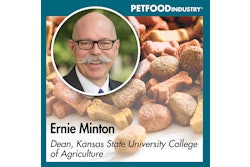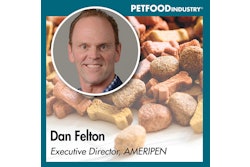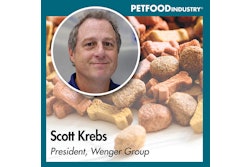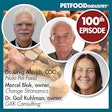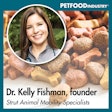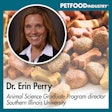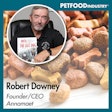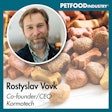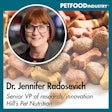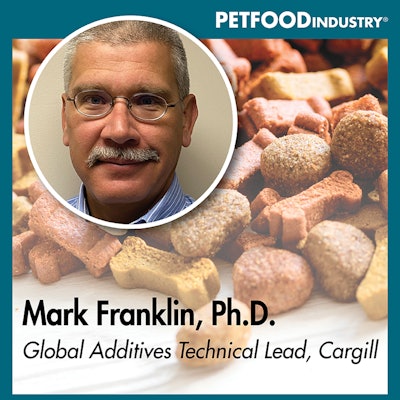
I spoke with Dr. Mark Franklin, global additives technical lead for pet and lifestyle with Cargill, about postbiotics as an additive in pet food formulations: Where it got started, where it is now and where it's going.
The below transcript is from Episode 47 of the Trending: Pet Food podcast, where I spoke with Dr. Mark Franklin, global additives technical lead for pet and lifestyle with Cargill, about postbiotics as an additive in pet food formulations. You can find the episode at www.PetfoodIndustry.com/trending-pet-food-podcast, on SoundCloud or on your favorite podcast platform. This episode originally aired on October 25, 2023.
Lindsay Beaton – Editor, Petfood Industry magazine and Host, Trending: Pet Food podcast Hello, and welcome to Trending: Pet Food, the industry podcast where we cover all the latest hot topics and trends in pet food. I’m your host and editor of Petfood Industry magazine Lindsay Beaton, and I’m here today with Dr. Mark Franklin, global additives technical lead for pet and lifestyle with Cargill. Hi Mark, and welcome!
Dr. Mark Franklin – Global Additives Technical Lead for Pet and Lifestyle, Cargill
Hi, Lindsay. Thank you so much for this opportunity to join you and your listeners.
Beaton: In case you're not familiar with Mark, here's what you need to know. As Global Additives Technical Lead, Mark is responsible for technical and customer support of Cargill’s vast additive portfolio across multiple species including dogs, cats, horses and backyard poultry. He has over 25 years of experience in animal nutrition, formulation and product development, and earned his B.S., M.S. and Ph.D. in Animal Science from the University of Tennessee at Knoxville.
Cargill helps the world's food system work for its customers, connecting farmers with markets, customers with ingredients and families with daily essentials, from the foods they eat to the floors they walk on. The company's global team members innovate with purpose, empowering partners and communities to work to nourish the world in a safe, responsible, sustainable way. Mark's years of industry experience, particularly in additives in animal nutrition, are why I've asked him on to answer today's question: What are the uses and opportunities of postbiotics in pet food formulations?
I always like to start our conversations with some background information, just to make sure everybody is on the same page. We already have prebiotics and probiotics, and those have been in use in the pet space and in the human space for quite a while now. How did postbiotics come about in general, and then how did they end up in the pet food space specifically?
Franklin: That's a great question to start with. I think we have a general lack of understanding around postbiotics. Consumers understand prebiotics and probiotics, right? They get the concepts there. When we introduce the term “postbiotic” it gets a little fuzzy for them. So prebiotic is, of course, what we would consider that bug food, what we're feeding the microbes in the intestine; probiotic would be feeding that live bug; and then postbiotic, moving on from that, would be feeding bugs and what that bug made in a fermentation outside of the animal. It's a trending ingredient, but most people probably don't realize that we've actually been using this for over 80-plus years.
Beaton: Are prebiotics and probiotics and postbiotics all parts of a whole, or are they all individual things that serve different purposes when it comes to formulation and health and nutrition?
Franklin: It kind of depends on what we're talking about. They’re the separate pieces making the whole. It's a little difficult to go into a podcast on a definition, but we do have a definition from the International Society of Prebiotics and Probiotics that came out last year (2022). And that definition says that postbiotics are a preparation of inanimate microorganisms and/or their components that confers a health benefit on the host. So, okay, wordy definition. But really, what does that mean? We interpret that rather refined. It's a pretty broad definition, but we've refined that to mean a nonliving microorganism with the metabolites it produces that shows a benefit in dogs and cats. So nothing filtered out, no pieces, no isolation, with species-specific results. If you look at a prebiotic, really you're just including into the diet a compound that you want the bugs that are already in the intestine to utilize. A probiotic, then, of course, is that live bug.
Well, the difficulty comes in, and I'm sure we'll get into it a little bit later, but the difficulty comes in how do you keep that functional? How do you keep probiotics alive? But the really big piece there for me is, you've got this fermentation going on in the intestine. That is subject to so many things. That is subject to how the animal’s feeling that day, it's subject to are they coming on or off a food change, did we just take a road trip together. There's so many things that influence what's going on in the gut of our dogs and cats that we might not always see the most consistent response if we're depending upon that fermentation to happen in the intestine. Postbiotics kind of takes a step back from that and say, “Hey, let's remove the variability. Let's do this fermentation outside of the variability of what's going on in the intestine.” And then we take the organism itself, and all the compounds it produced and the media on which it was grown, and that's what we use as a postbiotic.
Beaton: Is the ideal when it comes to formulation having all three of those things working together, or are there benefits to just using one of them or just using two of them? Because there are different products in the pet space that tout either prebiotics or probiotics or postbiotics; I am starting to see more that tout all of them together kind of as a system. So do all three of them together create a boost in terms of what they're able to do functionally?
Franklin: Potentially, Lindsay. Yeah, I would say by and large, the jury's still out on that question, if you will. Although we've had postbiotics for a long, long time, we're just now starting to look at those applications. And so, the initial work that we've done has been looking at a postbiotic sort of by itself, and seeing what those effects are on gut health and immune systems and all that. The really exciting space comes when we can start looking potentially at some of these synergies. Does a prebiotic plus a postbiotic give us a benefit over prebiotic or postbiotic alone? But how do you think about including probiotics into this? And then I think it's really going to start to tailor itself, you know, in our dogs and cats what benefits are we really going for? And does that then mean that we need a certain combination of postbiotic plus this prebiotic plus this probiotic, or maybe a different strain of probiotic? So I think we're in really early stages of starting to understand how these things really play together and can provide the most benefit to our pets.
Beaton: What kind of demand have you been seeing for postbiotics in pet food? And is that demand increasing? Is it becoming more complex? Are there certain ways that your customers are wanting to use postbiotics in their formulations that you're seeing over and over again?
Franklin: Yeah, for sure, we're seeing a lot of demand. As pet owners continue to look for those functional benefits in pet food and treats, we're seeing quite a bit of demand and that demand is actually growing. If you look at new pet product claims for postbiotics, they've grown 583% over the last three years. Now, that's not our data, that's Innova data from January 2020 to January of 2023. 583%. Customers are really interested, there's a lot of demand, they want to understand that. You know, again, as we just talked about, there's some questions around “Well, how does this play with what I'm already doing from a probiotic space?” Or, “How does this play with a prebiotic?” And so we're starting to understand that and get to some of those answers.
But we've seen particular interest around gut health improvement, what I referred to as proper immune function, skin and coat health, of course palatability, and even breath odor, Lindsay, we've got some pretty interesting work on reducing breath odor in dogs with the use of postbiotics. We of course believe this demand will continue to grow as the understanding grows, right; as pet parents understand more of the benefits that postbiotics can provide we expect this demand to continue growing.
Beaton: Is there a lot of research happening on the human side that is beneficial for figuring all of this out on the pet side as well? Because this kind of thing tends to work in tandem in the human and pet space.
Franklin: Absolutely. We're seeing that human trend around prebiotics, probiotics, postbiotics come more and more into play. And as that does, of course, we'll see that translate into our pet space, which is why we're really excited as a company. We're also working on that human side, and being able to translate those benefits and the research from human postbiotic work and probiotic work, of course, and then take that into this pet space, and really see if we can get those same benefits around digestive health, immune function, right, those that we've talked about, but then that translation from human to animal of course is trending.
Beaton: How important right now is the educational component? If you're in the middle of research, and you're trying to figure out where the synergies might lie, and there's stuff going on in the human space and stuff going on in the pet space, how educated do you think the end consumer is right now versus maybe they're attaching it to pre- and probiotics, which they probably know more about and are going okay, well, this makes sense that postbiotics serve some kind of functional benefit. Even if I don't quite understand what it is, I'm willing to give it a go. Where do you think we are in the end consumer education process when it comes to postbiotics?
Franklin: I think we're in the beginning stages to be quite honest. Consumers hear the term “-biotics” and I think they sort of kind of lump all those together: Pre-, pro-, pos-, okay, it's a -biotic. I understand the -biotic; I might not understand all the nuances of the differences, but I know in general I should expect these benefits, or I'm looking for these benefits. And there's a huge education piece that we need to do with that end consumer.
The really interesting thing to me is, even backing up, there's a lot of education we need to do with pet food suppliers and pet food nutritionists. Many times when I'm visiting with customers, it's a conversation around, “Okay, help me understand pre-, pro-, post-.” And so you provide that explanation and you kind of delineate where postbiotics come in. But then you go back to that definition that we referenced, and so because it is so broad, then we're left to refine that further as to what we mean by “postbiotic” when we, as Cargill, say “postbiotic.” So there's lots of different people out there talking about postbiotics, but in very different ways, so that overall education, even one level up from the consumer into the pet food supply chain, is still quite a bit of work to do.
Beaton: Where do you focus your efforts when you're doing that kind of education within the industry? Because I suppose it's possible that somebody comes to you and they say, “You know what, end consumer’s asking for this, we want this,” and then you sit down to do the education and it turns out, wait, that's not the direction they're trying to go, or it's something completely different from what they thought it was. How do you educate? Is it informal conversations? Do you have presentations that you give? How do you go about disseminating that information in the industry so that the larger industry can then serve the end consumer?
Franklin: Our dissemination efforts are everything from presenting at scientific meetings, abstracts, peer-reviewed journal articles, trying to really show the science behind what we're doing around postbiotics and what the potential is. And then when you get to that customer level, and the term that we use is: “What job is to be done?” We really want to intimately understand the job to be done, that the customer is trying to provide to the owner. We also then look at consumer insight around the job to be done. What are you really asking for? Are you asking for less digestive upset? What does that really mean? Less spots on the carpet or less accidents. So translating then, that job to be done, back to, and being very data-led here, with actual results from species work, dog and cat work. That's part of the translation that we take from the human side.
So great, we've got these clinical trial results on the human side, how are we thinking about that? And pets, we need to put the science behind that, we need to do the actual animal work. And I think that really starts to help the education, when you can sit down with a consumer or a customer and explain, “This is how it works. And this is the proof-positive benefit that we actually showed in a dog or a cat.”
Beaton: Is there any research you're doing right now that you're really excited about, that you think will either really bump up that educational component or really give postbiotics a more solid or clear place in the formulation space?
Franklin: Yeah, two areas there probably that really excite me. The first of those is around cat research. We often forget our cats. We focus on dogs and cats kind of get second shrift. So we've just completed some cat research that we're really excited about, and look forward to doing more research and understanding what the benefits to cats could be. And then the second area that's really an opportunity space that I see is around those process considerations. We struggled for a long time with probiotics and how to keep those bugs active and alive. We know that when we do and we deliver those to the gut, we know we see benefits. Oftentimes it's in the process, and so the particular opportunity I'm excited about is across all the pet food space, right? So dry, treats, wet — wet’s really hard. And so the beauty of postbiotics is it doesn't really matter what your process condition is. We've got very few things that are able to survive retort and keep providing the benefit, and the postbiotics can really play a role in this space so that we don't have to alienate or think, “Well, gosh, I'd like to be able to have this in a wet cat food, but I know it's not going to make it through the retort process.” Postbiotics provide us that opportunity, so really exciting there to be able to jump off more into that wet pet food space.
Beaton: That sounds very promising in terms of overcoming some of those challenges, because I know that there's always a lot of discussion about keeping the efficacy of ingredients throughout the entire production process and how that can be pretty difficult, especially for functional ingredients it seems.
Franklin: Absolutely.
Beaton: Let's keep talking about opportunities for postbiotics, since we're kind of launching off in that direction. What are some of the current opportunities for using postbiotics in pet food? What are most people using them for right now, and what is their most proven benefit right now?
Franklin: Most people are, of course, asking for those functional benefit areas around the ones that we've mentioned: Digestive health and immune function and skin and coat. But the science behind that is what's really exciting for me about the opportunity, and that science relates back to the microbiome. And so we're really excited about the changes that we're seeing in the microbiome and how that gut microbiome is having influence all over the body. We often refer to the gut as our second brain — I would argue when it gets close to lunchtime, it's my first brain — we know that that microbiome is having an effect on whole body systems, we talk pretty routinely about the gut-brain axis. But then recognizing all those other axes: The gut-skin axis, the gut-oral axis, the gut-reproductive tract axis, and how what we do to influence those bugs in the intestine are having an effect on skin and coat. I'm extremely excited about that, because we're starting to dig into that, we're starting to understand how these systems play together in more of a whole body concept. And I think that resonates really well with consumers, to talk to them in that way. Now, microbiome is a super complex topic; I'm not diminishing the complexity of microbiome, but we've got evidence that we're positively influencing that gut microbiome. And it opens up a whole new area of understanding in dogs and cats. That's really, really exciting.
Beaton: I agree. I think even on the human side, all of the discussion in the last few years that's really ramped up about the gut-brain connection and how all of that is working, and all the research that's being done, and the studies that are coming out, and then watching it in the pet space, too, has really enriched my knowledge of the potential for that area. And it feels like with every bit of research that anybody's doing in the space, it's just creating this 3D image of what exactly it is that's going on. And I feel like there is a lot to learn, still, which leads to a lot of potential for innovation in this space. So, is that one of the big things you, as part of Cargill, are hoping to do with your resources, is be able to really innovate in this space and get the research out there so that there's just a richer component to what postbiotics can do for pets and their health and nutrition?
Franklin: Yeah, absolutely. We're extremely interested in that innovation space, around influencing the microbiome. But referenced some work that we had done earlier around breath odor: Being able to then influence the gut microbiome to have an effect on dog stinky breath, completely unaware. We didn't go into the work looking for that. But that work was actually set up with a large in-home use test, and so of course the consumer has a questionnaire that they fill out. And you're asking about different areas. And we heard feedback that “Hey, my dog's breath is less stinky,” and it was just kind of like a light bulb went off for us. And we're like, “Oh, of course, gut microbiome, oral microbiome, what's the interplay there?” Imagine the innovation space that we can then play in and if we start to understand that.
Now, as these things become more able to deliver, one of the big pieces for that is all that massive data handling. And so the ability to handle all that data from these trials … imagine: Thousands of individual bug species, hundreds of families, how do you analyze them? How do you look for shifts in microbiome populations? More importantly, how do you monitor the genes that are turned on or off in the microbiome, as to their potential for a laundry list of things: Carbohydrate metabolism, protein metabolism, inflammatory markers, all that stuff. That's a massive amount of data, but the computational side is really catching up. And as the computation side catches up, then of course that means, just like the cost of the computer, the cost is going down, so we can analyze more and more and more data to really get after those insights to really start looking at those innovation pipelines that 15 years ago, we couldn't have done. The technology just didn't exist to be able to handle that. So that's really exciting from an innovative space.
Beaton: This might be a little bit of a 101 question, but I'm going to ask it anyway. How unique are individual microbiomes? Like, as we refine research — and we're in the thick of it right now, so this might be 10–20 years down the line — are postbiotics, could they end up being breed specific, or is there some kind of science where you could eventually test the microbiome of your pet and it could be part of customizing a pet food formulation, or are there general guidelines or rules that the microbiome of a dog follows that will allow you to cover everything no matter what life stage, no matter what breed? How specific can that research get, and can that targeting get?
Franklin: I think as we move forward with this, we absolutely will get more specific on that, and we got some great examples from other species in our work. In poultry, for example, we've developed systems where we can sample microbiome and predict what's going to happen with that flock. Hey, microbiome, this says, you're going to go through a feed efficiency issue in the coming days. And you’re really using that as a predictive model. We're not that far yet developed in dogs and cats, but you can imagine that's where we're going. And so breed-specific may be potentially, I think, one of the first areas that we'll tackle is what do we expect from this dog, for example. And its expected lifespan based on its breed, based on its mature body weight, size, what issues do we know dogs of this breed and relative mature adult body weight are going to have later in life? And so we can start monitoring that.
First of all, we've got to establish what normal is. And I must say, by and large, we've not seen that there's a real normal, so there's so much variability. And even within dogs in the same household, just like humans within the same household, there's quite a bit of difference in that microbiome and there's quite a bit of difference of how they would then respond to normal, everyday living activities. So it takes a massive amount of data to try and start to understand what sort of “normal” is, but great hope from some work and other species that we've done, that we can keep refining this and get more and more precise, so that, imagine the day where you've got a dog that later in life, you know, they're going to go through some issues. And we start getting ready for that. And you couple that with almost a diagnostic tool that says, “Hey, your yearly checkup to the vet hasn't seen this start to change yet, but we'll keep watching it. Oh, yeah, we're starting to see this changed microbiome, an early indicator of that.” What can we then do to improve the quality of life or to help that animal through that stage? Unbelievable potential, but lots of understanding still to go.
Beaton: That is fascinating, because I have had several conversations recently that revolved around an evolution in the pet food industry that involves really focusing on preventive and maintenance health. So, we all know that pets are living longer lives with increased veterinary science and better nutrition, and all the things we've done have worked together to increase the lifespan of our pets. And we're starting to look at things like, maybe our pets need a multivitamin, a daily multivitamin that they take, you know, the pet equivalent of what we do as humans, just to try to foresee things that might be coming down the road and maybe make them a little less difficult for ourselves in our older ages. And so, it sounds like this — postbiotics and the research behind it — could be going in that direction as well, where you can use it as part of that conversation and say, “Look, we could potentially have the ability to see what might be happening, so why don't we start mitigating it now and just make it a part of daily nutrition?
Franklin: Absolutely. And I would say, you know, in fairness to this point, most of the work that's been done in the space — prebiotic, probiotic postbiotic, of course — has been with what we would consider a healthy animal. They're not in a disease state. This is not a drug. We're not looking to cure, so I'm not going there. But what I'm saying is, we're starting to understand some of those changes as those common daily stressors occur. You want to go away for the weekend with your dogs and it's a six-hour ride. You throw them in the car with you, you're going camping for the weekend, six-hour drive. What's that doing to the dog's microbiome? What's that do into the dog's intestine? Certainly there is a potential for psychological stress or physical stress and travel stress. How do we understand that? If I know in two weeks I'm going camping with my dogs, do I need to do anything to get ready for that? Most of us think about it if we traveled internationally, what do I need to think about traveling internationally? Do I need to start a course of postbiotics from our human side? Do I need to start that couple of weeks before I travel? And thinking about what I might experience in different food, different culture, different environment, how to get used to that.
So I think that translates from human into our pet space; lots of opportunity to understand what those normal everyday stressors are doing that might be causing those issues that we don't really want to deal with.
Beaton: We've talked a lot about education and research and where we're at with that, and how there's still a lot to be done. Technically speaking, are there any challenges around using postbiotics in formulation? Towards the beginning of our conversation, we touched a little bit on prebiotics and probiotics, and the form the pet food takes and how that might affect efficacy. Are there any similar challenges for formulating with postbiotics?
Franklin: I would say there's an advantage and some challenges. That advantage we've talked about a little bit, not having to worry about what process step I'm going to have to go through: Extrusion, retort, drying, whatever. So, huge advantage there. Actually, from a formulation benefit, low inclusion levels provide us formulation space, which is often an advantage. We hear our customers tells us it’s an advantage, particularly if you're looking at a supplement or a treat application. You can only cram so much into so small a space. So an advantage there.
One of the challenges that we're working through is, particularly on dog, not so much on cat, you can have a 3-pound adult Chihuahua and a 250-pound Great Dane; the challenge is to deliver the right amount of postbiotic to that animal. And so we take a very different view on that. We want to deliver so many milligrams of postbiotic per kilogram of body weight daily. And so it's a dynamic dose, and taking into consideration yes, of course, a Great Dane is going to eat quite a bit more than that Chihuahua, but how do you deliver that right dose on a milligram per kilogram body weight basis? So we're really moving away from that pounds-per-ton concept in formulation. And sometimes if you're looking at products, you know, that are intended to feed a wide range of adult dogs, there can be some formulation challenges and making sure that we're delivering spot-on target that amount of postbiotic.
Beaton: I want to wrap up our conversation by looking towards the future, because it sounds like there is a lot of potential in terms of where we're going to be even a couple years from now in terms of research and the ability and knowledge of postbiotics in the pet food space. Based on current trends and the current research, where do you see the future of postbiotics and pet food? And then how long do you think it's going to take us to get there?
Franklin: Great question. Crystal ball question. Certainly, the future is understanding the postbiotic influence on microbiome and the total microbiome systems. And then within that, Lindsay, understanding what influence the microbiome is having as they were influenced by the postbiotic. So, case in point, we know the microbiome affects the immune system, we know that that immune system needs to be primed and ready to go when we face a challenge. Of course, we don't want the immune system turned on when we don't have a challenge. That's not good for the animal. But understanding those links back to, “Okay, the immune system is ready to go because the microbiome was influenced, because the postbiotic did that.” And so then you start to see where that future potential is in understanding how those body systems work, and to be able to really bring a meaningful benefit to the consumer on what they're looking for.
Understanding postbiotic influence on the total dog and cat microbiome will continue to be a future focus area for us, because we want to bring it to those benefits that the pet owners are looking for. Now, we think our position within the human and pet nutrition sectors, coupled with animal expertise, really allows us to develop and translate these future innovations. I think postbiotic applications in our pets are just getting really started. They've got a super bright future. As for timeline, yeah, you kind of already mentioned it: Probably three to five years, maybe even a bit longer down the road before we start to completely understand some of these systems; even longer than that when we start linking up systems together. But the exciting part today is we're seeing those benefits. Customers are telling us “Hey, I'm noticing these benefits that I'm asking for.” And as we start to understand that more the idea there is to refine those and bring those even to a better place for our customers.
Beaton: Well, I really appreciate you chatting with me today about postbiotics, because like you said they are making their way further into pet nutrition, and there's even more going on in research in their interplay among all the different -biotics than I realized. So I have learned a lot today and I have a feeling that a lot of people listening probably learned a lot today, as well.
Before we go, let's do a little plug: Where can people find more information about you and about Cargill?
Franklin: Absolutely. So, you can certainly find me on LinkedIn, Mark Franklin. And then as far as Cargill, I would direct people to website www.trumune.com.
Beaton: Excellent. That is it for this episode of Trending: Pet Food. You can find us on www.PetfoodIndustry.com, SoundCloud or your favorite podcast platform. You can also follow us on Instagram @trendingpetfoodpodcast. And if you want to chat or have any feedback, I'd love to hear from you. Feel free to drop me an email: [email protected]. Once again, I'm Lindsay Beaton, your host and Editor of Petfood Industry magazine, and we'll talk to you next time. Thanks for tuning in!


